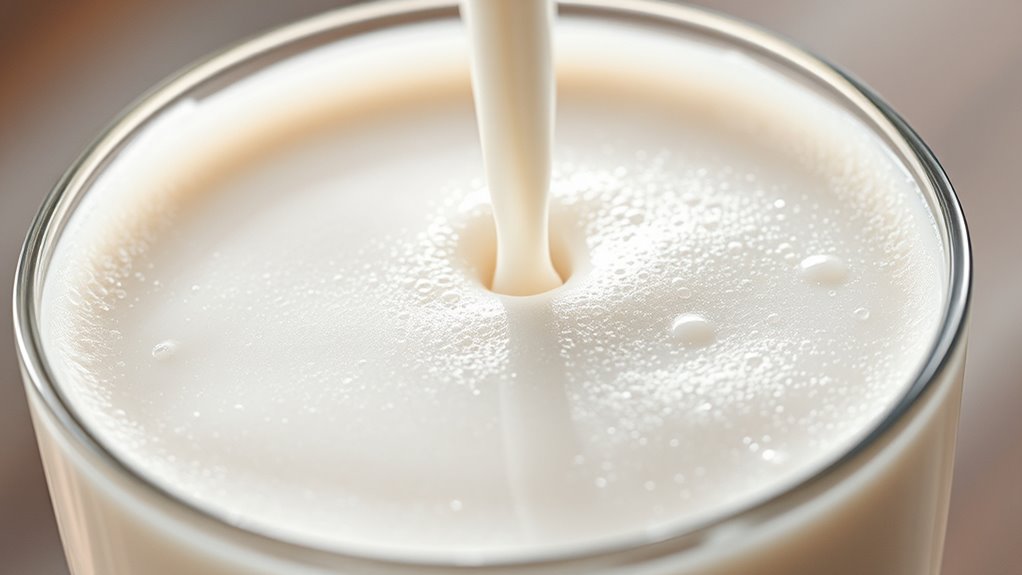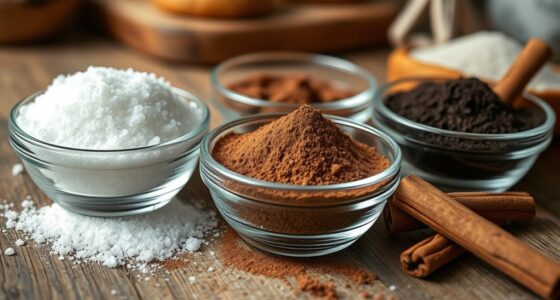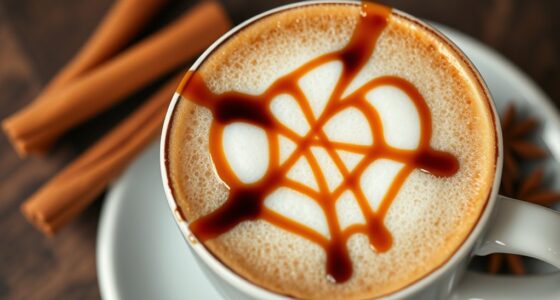When you froth milk, proteins like whey unfold and form a network that traps air, creating foam, while fats stabilize these bubbles and give the foam a creamy texture. Heating helps proteins denature and bond, enhancing foam stability. The milk’s composition and processing methods influence how well it produces microfoam. Keep exploring to understand how different techniques impact the silky, stable foam you enjoy in your favorite drinks.
Key Takeaways
- Proteins, especially whey, denature and form networks during heating, trapping air to create foam.
- Fats stabilize air bubbles by forming a film around them, preventing collapse and increasing foam stability.
- Heat treatment unfolds milk proteins, enhancing their ability to form cohesive films around microbubbles.
- The composition of milk, including protein and fat content, directly influences the microfoam’s appearance and stability.
- Proper dairy processing alters protein and fat structures, optimizing milk’s capacity to produce fine, velvety microfoam.

Have you ever wondered what makes milk such an essential part of our diets? It all comes down to its unique composition, carefully crafted through the process of dairy processing. Milk is a complex liquid, packed with nutrients that support growth and health. Its composition includes water, proteins, fats, carbohydrates, vitamins, and minerals. The proteins, mainly casein and whey, serve more than just nutritional roles; they are crucial in creating microfoam, especially in coffee or culinary applications. Fats provide richness and texture, influencing how milk interacts when processed or heated. Understanding this composition helps you see why milk can produce such fine, stable foam when properly handled. Notably, the dairy processing methods used significantly influence the milk’s ability to produce high-quality foam.
In dairy processing, milk undergoes several steps to prepare it for various uses, from drinking to foam creation. During pasteurization, heat treatment kills harmful bacteria, but it also slightly alters the structure of milk’s proteins and fats. This change is essential because it makes the milk safer while preserving its ability to foam. When you steam milk for a latte or cappuccino, you’re leveraging these processed components to create microfoam. The proteins, especially whey proteins, unfold and form networks that trap tiny air bubbles, giving the foam its smooth, velvety texture. Fats also play a vital role by stabilizing these bubbles, preventing them from collapsing too quickly.
The process of milk foaming is a delicate dance between its composition and how you manipulate it. When you heat milk, the proteins denature and align to form a film around the air bubbles. The fats contribute to the foam’s creaminess, making it more resistant to breaking apart. If the milk’s composition isn’t ideal—say, if it’s too low in fat or proteins—the foam won’t be as stable or luxurious. This is why baristas often select whole milk or specific dairy products for the best microfoam. The precise dairy processing methods used to prepare milk influence how well it can hold foam, which is why different types of milk—skim, whole, or alternative dairy—behave differently when frothed.
Frequently Asked Questions
How Does Temperature Affect Protein and Fat Interactions in Milk?
Temperature impacts protein and fat interactions by causing protein denaturation and enhancing fat emulsification. When milk heats up, proteins unfold, allowing better aeration and foam stability. Higher temperatures also improve fat emulsification, creating a smoother, creamier microfoam. However, too much heat can break down proteins and fats, weakening the foam structure. So, maintaining ideal temperature is key to achieving perfect microfoam with well-balanced protein and fat interactions.
Can Plant-Based Milks Create Similar Microfoam as Dairy Milk?
You can create microfoam with plant-based milks, but it’s not always as easy as with dairy. Plant-based proteins and fat mimetics help stabilize and trap air, mimicking dairy’s foam properties. You need to choose options with higher protein content and added fat mimetics, then steam and froth carefully. With practice, you can achieve similar microfoam, enjoying plant-based drinks that look and feel just as delightful.
What Role Do Enzymes Play in Milk Foaming Properties?
Enzymes play a vital role in milk foaming by aiding enzyme activation, which helps break down proteins and fats, improving foam formation. They also contribute to foam stabilization, ensuring the microfoam stays intact longer. When you steam milk, enzymes enhance the interaction between proteins and fats, creating a stable, creamy foam. Understanding this process helps you achieve better microfoam, whether you’re using dairy or plant-based alternatives.
How Does Milk Composition Vary Across Different Dairy Breeds?
Imagine each dairy breed as a different artist with a unique palette. Breed differences in milk composition mean some produce milk rich in fats and proteins, perfect for creating velvety microfoam, while others have lighter milk. These variations influence texture and flavor, so when you choose a breed, you’re selecting a specific art style that impacts your final coffee experience. Your choice shapes the richness and stability of your milk foam.
Are There Additives That Improve Milk’s Microfoam Stability?
You can improve milk’s microfoam stability by using additives like milk stabilizers and foam enhancers. These ingredients help maintain a consistent microfoam by preventing bubbles from collapsing and ensuring even distribution of proteins and fats. When choosing these additives, look for food-grade options compatible with dairy milk. Properly incorporating stabilizers and foam enhancers will give you a longer-lasting, smooth microfoam perfect for your coffee creations.
Conclusion
Now that you understand how proteins and fats dance together to create microfoam, you’re like a maestro in your own kitchen. With each froth you craft, you’re painting a tiny masterpiece of bubbles and cream, turning simple milk into a velvety cloud. So, next time you steam or froth, remember—you’re wielding the secrets of milk’s magic, transforming everyday ingredients into a silky symphony that elevates every sip.









